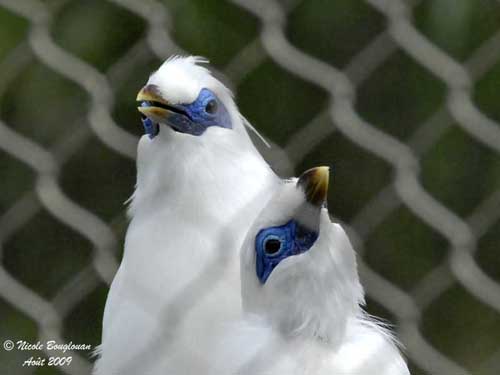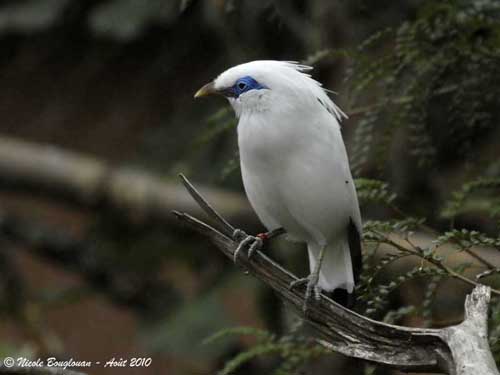
PROTECTION / THREATS / STATUS:
The Bali Myna is a Critically Endangered species. It has restricted range, its habitat is destroyed, woodlands are converted to exotic plantations, but the major threat is the illegal pet-trade for cagebirds, and this threat still remains today.
Several releases of captive-bred birds involve the establishment of new populations, and these birds breed in wild, but the illegal pet-trade still continues. There are about two or three tens of birds in Bali.
Fr: Etourneau de Rothschild
All : Balistar
Esp : Estornino de Bali
Ital : Maina di Rothschild
Nd : Bali-spreeuw
Text and pictures by Nicole Bouglouan
Pictures taken at London Zoo (UK).
Sources :
HANDBOOK OF THE BIRDS OF THE WORLD Vol 14 by Josep del Hoyo-Andrew Elliot-David Christie - Lynx Edicions –
ISBN: 9788496553507
STARLINGS AND MYNAS, by Chris Feare and Adrian Craig. Christopher HELM - ISBN: 071353961X
L’ENCYCLOPEDIE MONDIALE DES OISEAUX - Dr Christopher M. Perrins - BORDAS - ISBN: 2040185607
BirdLife International (BirdLife International)
Wikipedia (Wikipedia, The Free Encyclopedia)
Bali Myna
Leucopsar rothschildi
Passeriforme Order – Sturnidae Family
BIOMETRICS:
Length: 25 cm
Weight: 70-115 g
DESCRIPTION:
This Critically Endangered species is the national symbol of the Island of Bali. This beautiful bird has been discovered in 1912. Its scientific name comes from the British ornithologist Lord Rothschild.

The Bali Myna is almost all white, except for black tips on primary feathers and black terminal band on tail.
The head shows elongated white feathers on crown and nape, forming a crest. The bare facial skin extends from the lores and around the eyes, to a point behind the eye. This skin is bright cobalt-blue.
Eyes can be grey, whitish or brown. The bill is grey or brown with yellow tip. Legs and feet are bluish-grey.
Both sexes are similar, but female has shorter crest than male and she is slightly smaller.
The juvenile may have smoky wash on the back, and some cinnamon on the wings. Its crest is shorter than in adults, and sometimes absent.
VOICE: SOUNDS BY XENO-CANTO
The Bali Myna’s alarm call is a loud “tschick tschick tschick”. When it takes off, it gives a “creer” and a loud “kwik-kwi”.
The song includes loud chattering notes, whistles and high-pitched notes. Displays by both sexes are accompanied by songs, especially a quiet chattering during the bowing display. The song is uttered whereas the bird bows while raising the crest feathers.
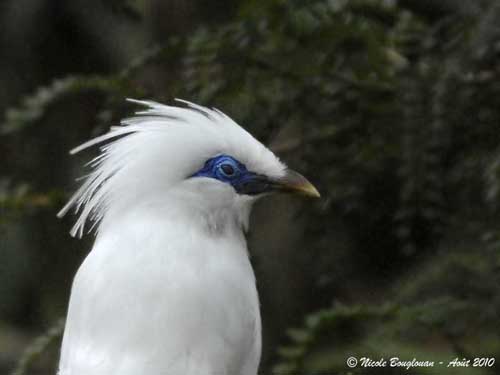
HABITAT:
The Bali Myna frequents open woodland with grassy understorey, from tall grass with scattered trees, to woodland with spaced trees.
This species seems to avoid the closed forest.
RANGE:
The Bali Myna has restricted range. The species occurs on the Island of Bali in Indonesia, and especially in NW Bali.
It is resident in its range.
BEHAVIOUR:
The Bali Myna feeds mainly on insects caught on the ground, but it also takes small reptiles and fruits. It is usually mainly arboreal when foraging, but it also can be seen on the ground when it hunts for feeding the young. It may sometimes forage for insects close to mammals.
Outside the breeding season, the Bali Myna is gregarious, living in flocks of up to 30-60 birds. They roost communally at night, arriving in small groups of 3-6 birds. These roosts are in tall trees such as dense Coconuts, or in shrubby undergrowth at 2-4 metres above the ground. Within the roost, the pairs sleep together.
During daytime, they may rest with other Sturnidae species.
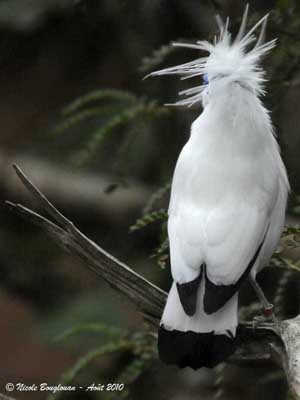
But when the breeding season starts, the Bali Myna becomes territorial and aggressive, and probably roosts within its territory. They are aggressive and defend strongly the area.
The Bali Myna performs courtship displays. Allopreening is common between mates, often directed to the bare blue facial skin, and to the whole head. Both partners also perform bobbing displays during which the bird bobs head and breast up and down while perched on a branch. But when it is very excited, it bobs the entire body while shaking strongly the perch.
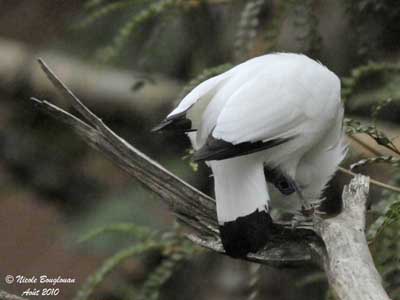
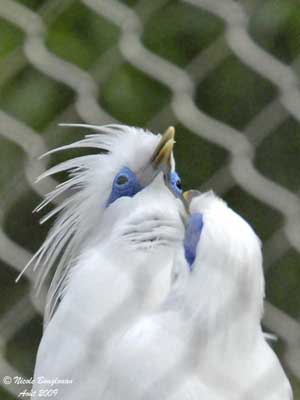
During the displays, the crest is raised and the bird moves the throat feathers which are fluffed.
These displays are usually accompanied by low chattering or low growl.
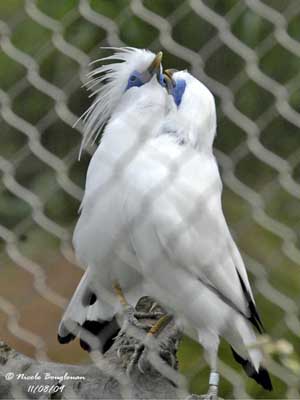
Other displays such as bowing followed by preening occur. Both mates are close to each other and the male exposes its long crest by bowing or by turning the head to present the nape and the raised crest to the female. When she is ready to mate, she performs sideways vibrations of the tail.
FLIGHT:
The Bali Myna appears stocky when in flight. Wings are rounded and the tail is short. The black tip of the primary flight feathers and tail are conspicuous.
REPRODUCTION:
The Bali Myna breeds during the rainy season, between January and April. The species is monogamous and has long-term pair-bonds.
The nest is placed in tree hole, and an abandoned woodpecker’s hole is often used. Both mates line the nest with dry twigs and grass. It is placed at 4-10 metres above the ground. This species may nest in nest-boxes in captivity.
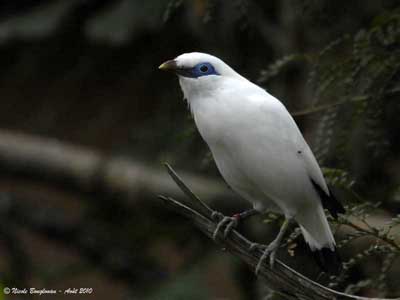
Female lays 2-3 pale blue eggs with some pale brown spots. Incubation is by female, and lasts 12-15 days. The chicks hatch naked and with closed eyes. They are brooded by female, but both parents feed them. The nestling period lasts between 22 and 24 days, but the young still depend on parents for food for up to 7 weeks after fledging. But they start to feed themselves at 4-5 weeks of age. Usually, only one chick survives to the fledging stage.
DIET:
The Bali Myna is omnivorous, feeding on fruits and seeds, insects, worms and small reptiles.
It takes berries of all sizes, and also large fruits of Ficus and Morus species, and seeds of deciduous Sterculia foetida.
It consumes insects, caterpillars, ants, termites, dragonflies and grasshoppers, mainly during the rains and the nesting period.
The Bali Myna is mainly arboreal, but it may forage on the ground.
